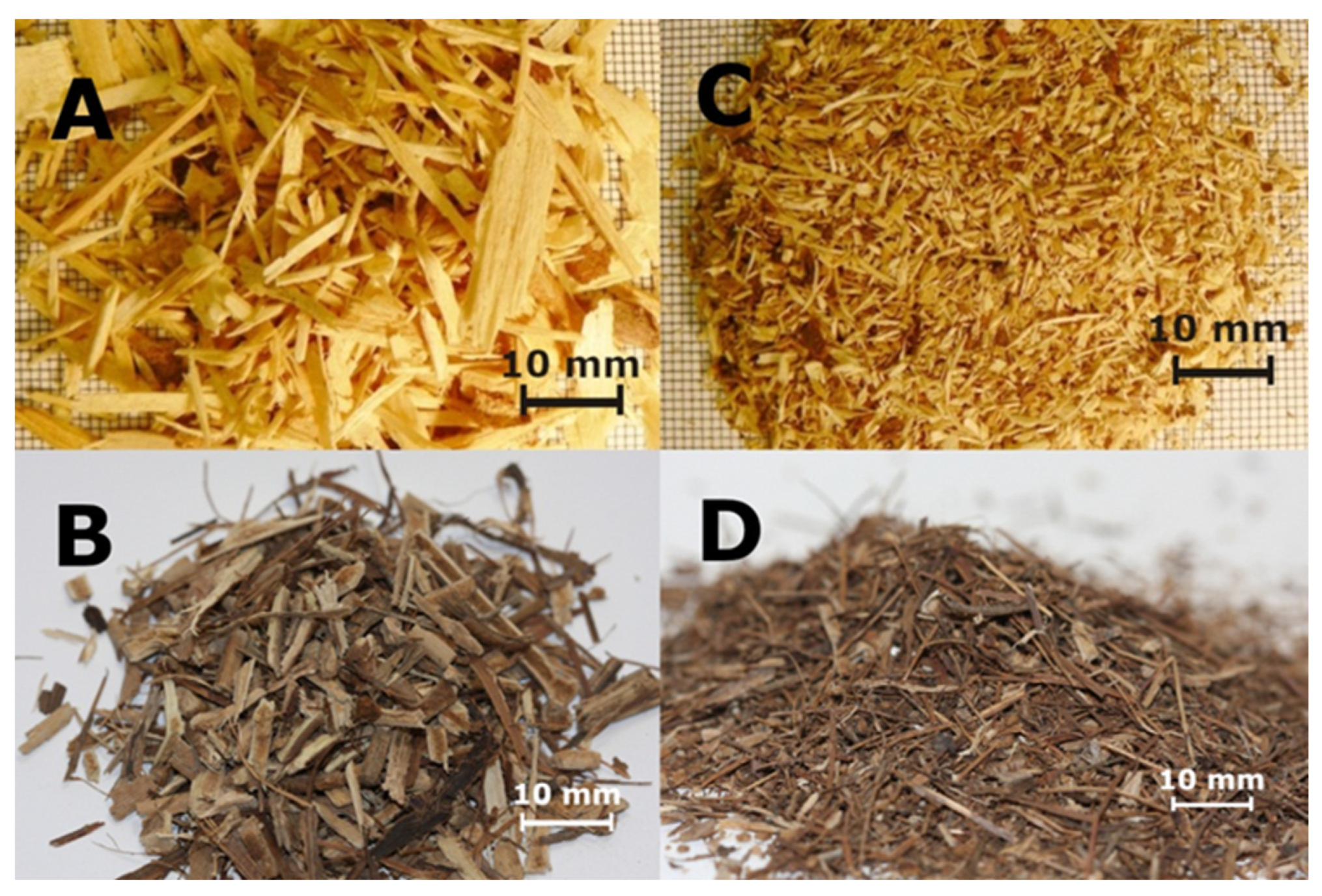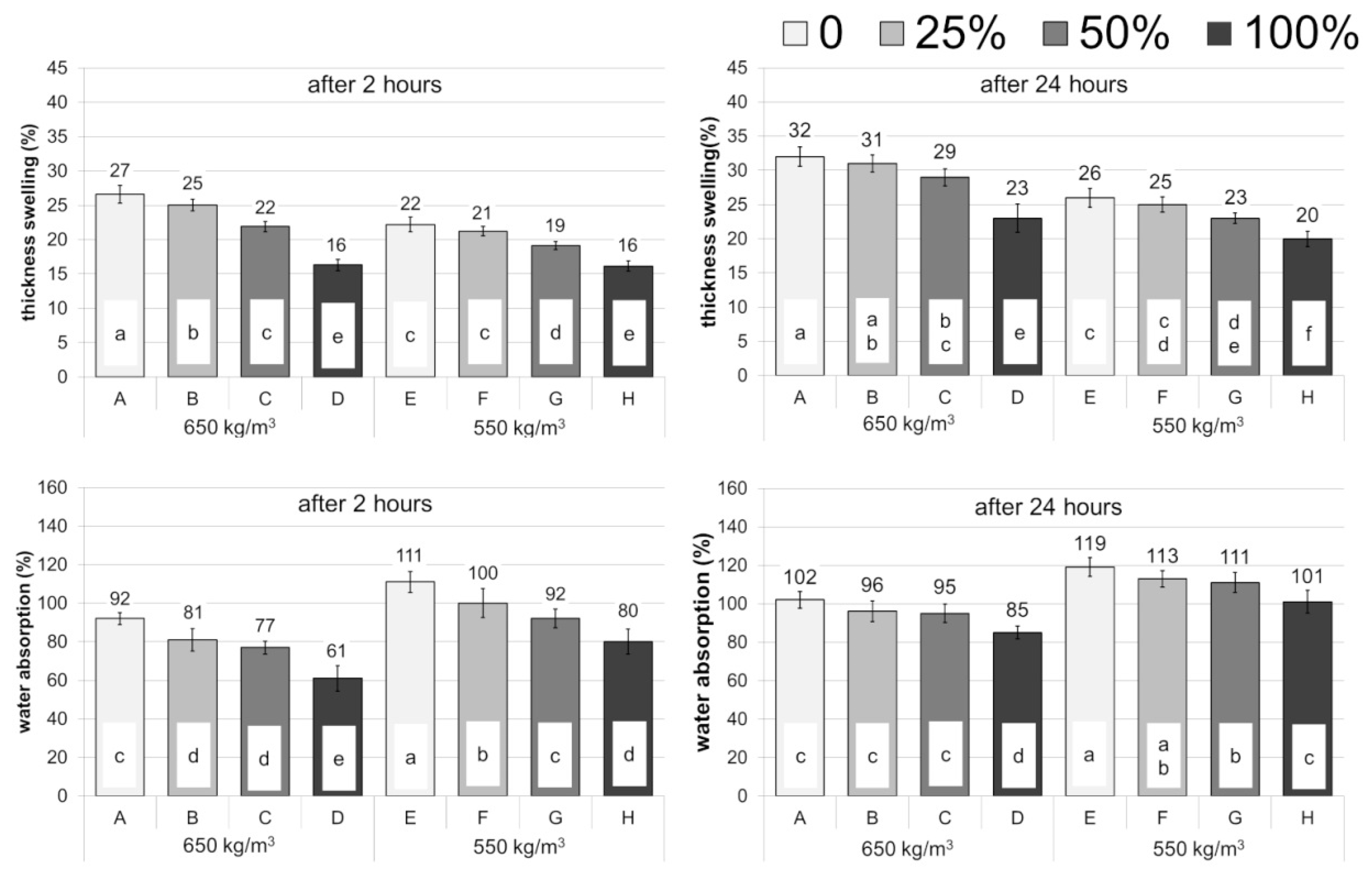Lignocellulosic Biomass from Grapevines as Raw Material for Particleboard Production
Abstract
:1. Introduction
2. Materials and Methods
2.1. Raw Materials
2.2. Adhesives
2.3. Particleboard Manufacturing
2.4. Mechanical and Physical Properties
2.5. Susceptibility to Drilling
2.6. Statistical Analysis
3. Results
4. Conclusions
Author Contributions
Funding
Institutional Review Board Statement
Informed Consent Statement
Data Availability Statement
Conflicts of Interest
References
- MINECO. The Spanish Bioeconomy Strategy—2030 Horizon; European Commission: Luxembourg, 2016; pp. 1–46. [Google Scholar]
- Duque-Acevedo, M.; Belmonte-Ureña, L.J.; Cortés-García, F.J.; Camacho-Ferre, F. Agricultural Waste: Review of the Evolution, Approaches and Perspectives on Alternative Uses. Glob. Ecol. Conserv. 2020, 22, e00902. [Google Scholar] [CrossRef]
- EIP-AGRI. EIP-AGRI Workshop “Opportunities for Agriculture and Forestry in the Circular Economy”; Workshop Report European Innovation Partnership: Brussels, Belgium, 2015. [Google Scholar]
- Mohanty, A.K.; Misra, M.; Drzal, L.T. Sustainable Bio-Composites from Renewable Resources: Opportunities and Challenges in the Green Materials World. J. Polym. Environ. 2002, 10, 19–26. [Google Scholar] [CrossRef]
- Scarlat, N.; Dallemand, J.F.; Monforti-Ferrario, F.; Nita, V. The Role of Biomass and Bioenergy in a Future Bioeconomy: Policies and Facts. Environ. Dev. 2015, 15, 3–34. [Google Scholar] [CrossRef]
- FAOSTAT. Available online: http://www.fao.org/faostat/en/#data/FO (accessed on 7 July 2020).
- Klímek, P.; Wimmer, R.; Meinlschmidt, P.; Kúdela, J. Utilizing Miscanthus Stalks as Raw Material for Particleboards. Ind. Crops Prod. 2018, 111, 270–276. [Google Scholar] [CrossRef]
- Wang, D.; Sun, X.S. Low Density Particleboard from Wheat Straw and Corn Pith. Ind. Crops Prod. 2002, 15, 43–50. [Google Scholar] [CrossRef]
- Adediran, A.A.; Olawale, O.; Ojediran, J.; Aladegboye, S.; Atoyebi, O.D.; Akinlabi, E.T.; Olayanju, T.M.A. Properties of Agro-Based Hybrid Particleboards. Procedia Manuf. 2019, 35, 442–446. [Google Scholar] [CrossRef]
- Kalaycioglu, H.; Nemli, G. Producing Composite Particleboard from Kenaf (Hibiscus Cannabinus L.) Stalks. Ind. Crops Prod. 2006, 24, 177–180. [Google Scholar] [CrossRef]
- Khristova, P.; Yossifov, N.; Gabir, S. Particle Board from Sunflower Stalks: Preliminary Trials. Bioresour. Technol. 1996, 58, 319–321. [Google Scholar] [CrossRef]
- Klímek, P.; Meinlschmidt, P.; Wimmer, R.; Plinke, B.; Schirp, A. Using Sunflower (Helianthus Annuus L.), Topinambour (Helianthus Tuberosus L.) and Cup-Plant (Silphium Perfoliatum L.) Stalks as Alternative Raw Materials for Particleboards. Ind. Crops Prod. 2016, 92, 157–164. [Google Scholar] [CrossRef]
- Taha, I.; Elkafafy, M.S.; El Mously, H. Potential of Utilizing Tomato Stalk as Raw Material for Particleboards. Ain Shams Eng. J. 2018, 9, 1457–1464. [Google Scholar] [CrossRef] [Green Version]
- Pirayesh, H.; Khazaeian, A. Using Almond (Prunus Amygdalus L.) Shell as a Bio-Waste Resource in Wood Based Composite. Compos. Part B Eng. 2012, 43, 1475–1479. [Google Scholar] [CrossRef]
- Nemli, G.; Kirci, H.; Serdar, B.; Ay, N. Suitability of Kiwi (Actinidia Sinensis Planch.) Prunings for Particleboard Manufacturing. Ind. Crops Prod. 2003, 17, 39–46. [Google Scholar] [CrossRef]
- Auriga, R.; Borysiuk, P.; Gumowska, A.; Smulski, P. Influence of Apple Wood Waste from the Annual Care Cut on the Mechanical Properties of Particleboards. Ann. Warsaw Univ. Life Sci.—SGGW For. Wood Technol. 2019, 105, 47–53. [Google Scholar] [CrossRef]
- Nasser, R.A.; Nasser, R.A.; Al-Mefarrej, H.A.; Abdel-Aal, M.A. Suitability of Vine (Vitis Vinifera L.) Prunings for Wood-Cement Industry. Environ. Sci. 2011, 11, 903–910. [Google Scholar]
- Ntalos, G.A.; Grigoriou, A.H. Characterization and Utilisation of Vine Prunings as a Wood Substitute for Particleboard Production. Ind. Crops Prod. 2002, 16, 59–68. [Google Scholar] [CrossRef]
- Yeniocak, M.; Göktaş, O.; Erdil, Y.Z.; Özen, E.; Alma, M.H. Investigating the Use of Vine Pruning Stalks (Vitis Vinifera L. CV Sultani) as Raw Material for Particleboard Manufacturing. Wood Res. 2014, 59, 167–176. [Google Scholar]
- Yeniocak, M.; Goktas, O.; Ozen, E.; Gecgel, A. Improving Mechanical and Physical Properties of Particleboard Made from Vine (Vitis Vinifera l.) Prunings by Addition Reinforcement Materials. Wood Res. 2016, 61, 265–274. [Google Scholar]
- Borysiuk, P.; Jenczyk-Tolloczko, I.; Auriga, R.; Kordzikowski, M. Sugar Beet Pulp as Raw Material for Particleboard Production. Ind. Crops Prod. 2019, 141, 111829. [Google Scholar] [CrossRef]
- Zvirgzds, K.; Kirilovs, E.; Kukle, S.; Gross, U. Production of Particleboard Using Various Particle Size Hemp Shives as Filler. Materials 2022, 15, 1–19. [Google Scholar] [CrossRef]
- OIV. State of the World Vitivinicultural Sector in 2020. Int. Organ. Vine Wine. 2021, pp. 1–19. Available online: https://www.oiv.int/public/medias/7909/oiv-state-of-the-world-vitivinicultural-sector-in-2020.pdf (accessed on 7 July 2020).
- EUROSTAT. Available online: https://ec.europa.eu/eurostat/data/database (accessed on 7 July 2020).
- EN 310; Wood-Based Panels—Determination of Modulus of Elasticity in Bending and of Bending Strength. European Comittee for Standardization: Brussels, Belgium, 1994.
- EN 319; Particleboards and Fibreboards—Determination of Tensile Strength Perpendicular to the Plane of the Board. European Comittee for Standardization: Brussels, Belgium,, 1999.
- EN 323; Wood-Based Panels—Determination of Density. European Comittee for Standardization: Brussels, Belgium, 1999.
- EN 317; Particleboards and Fibreboards—Determination of Swelling in Thickness after Immersion in Water. European Comittee for Standardization: Brussels, Belgium, 1999.
- Boruszewski, P.; Borysiuk, P.; Maminski, M.; Czechowska, J. Mat Compression Measurements during Low-Density Particleboard Manufacturing. BioResources 2016, 11, 6909–6919. [Google Scholar] [CrossRef] [Green Version]
- Cosereanu, C.; Brenci, L.M.; Zeleniuc, O.; Fotin, A. Effect of Particle Size and Geometry on the Performance of Single-Layer and Three-Layer Particleboard Made from Sunflower Seed Husks. BioResources 2015, 10, 1127–1136. [Google Scholar] [CrossRef] [Green Version]
- Niemz, P.; Sandberg, D. Critical Wood-Particle Properties in the Production of Particleboard. Wood Mater. Sci. Eng. 2022, 1–2. [Google Scholar] [CrossRef]
- Medved, S.; Jambreković, V. The Influence of the Structure of Three-Layer Particle Boards on the Thickness and Density of Surface Layer. Drv. Ind. 2000, 51, 9–18. [Google Scholar]
- Rowell, R.M. Handbook of Wood Chemistry and Wood Composites; CRC Press: Boca Raton, FL, USA, 2013; ISBN 9781439853801. [Google Scholar]
- Niemz, P. Physik Des Holzes Und Holzwerkstoffe; Carl Hanser Verlag GmbH & Co. KG: Munich, Germany, 2003. [Google Scholar]
- Medved, S.; Resnik, J. Impact of Beech Particle Size on Compaction Ratio of the Surface Layer. Wood Res. 2007, 52, 101–108. [Google Scholar]
- Wong, E.D.; Zhang, M.; Wang, Q.; Kawai, S. Formation of the Density Profile and Its Effects on the Properties of Particleboard. Wood Sci. Technol. 1999, 33, 327–340. [Google Scholar] [CrossRef]
- Treusch, O.; Tröger, F.; Wegener, G. Einfluss von Rohdichte Und Bindemittelmenge Auf Das Rohdichteprofil von Einschichtigen Spanplatten. Holz als Roh—und Werkst. 2004, 62, 474–475. [Google Scholar] [CrossRef]
- EN 312; Particleboards—Specyfications. European Comittee for Standardization: Brussels, Belgium, 2011.
- Mahieu, A.; Alix, S.; Leblanc, N. Properties of Particleboards Made of Agricultural By-Products with a Classical Binder or Self-Bound. Ind. Crops Prod. 2019, 130, 371–379. [Google Scholar] [CrossRef]
- Podziewski, P.; Wilkowski, J.; Górski, J. Machinability Rating of Wood Materials for Drilling. In Proceedings of the Chip and Chipless Woodworking Processes: The 8th International Science Conference—Proceedings of Papers, Zvolen, Slovakia, 6–8 September 2012; pp. 279–284. [Google Scholar]





| Fraction (mm) | Industrial Wood Particles | Vine Pruning Waste Particles | ||
|---|---|---|---|---|
| Core Layers | Face Layer | Core Layers | Face Layer | |
| 6.00 | 13.0 | - | 26.6 | - |
| 4.00 | 19.0 | - | 43.7 | - |
| 2.00 | 51.0 | 0.6 | 18.4 | - |
| 1.25 | 13.0 | 14.3 | 6.1 | 17.6 |
| 0.63 | 3.6 | 55.5 | 3.2 | 39.4 |
| 0.49 | 02 | 11.4 | 0.6 | 7.6 |
| 0.315 | 0.1 | 7.8 | 0.6 | 19.0 |
| below 0.315 | 0.1 | 10.4 | 0.8 | 16.4 |
| Characteristic | Value |
|---|---|
| dry mass | 67.0% |
| pH | 8.0 |
| dynamic viscosity | 500 mPas |
| Variant | Density (kg/m3) | Share of Vine Pruning Particles (%) |
|---|---|---|
| A | 650 | 0 |
| B | 650 | 25 |
| C | 650 | 50 |
| D | 650 | 100 |
| E | 550 | 0 |
| F | 550 | 25 |
| G | 550 | 50 |
| H | 550 | 100 |
| Variant | |||||||||
|---|---|---|---|---|---|---|---|---|---|
| A | B | C | D | E | F | G | H | ||
| Density (kg/m3) | Average | 669 | 668 | 666 | 666 | 579 | 569 | 568 | 563 |
| ±Std. Dev | 38 | 34 | 38 | 37 | 35 | 34 | 32 | 38 | |
| MOR | MOE | IB | ||||
|---|---|---|---|---|---|---|
| p | Pc (%) | p | Pc (%) | p | Pc (%) | |
| share | 0.000 | 46.66 | 0.000 | 56.60 | 0.000 | 10.07 |
| density | 0.000 | 41.84 | 0.000 | 32.42 | 0.000 | 66.18 |
| share x density | 0.556 | 0.32 | 0.104 | 0.90 | 0.206 | 1.45 |
| error | 11.17 | 10.08 | 22.30 | |||
| TS2H | TS24H | WA2H | WA24H | |||||
|---|---|---|---|---|---|---|---|---|
| p | Pc (%) | p | Pc (%) | p | Pc (%) | p | Pc (%) | |
| share | 0.000 | 74.91 | 0.000 | 47.57 | 0.000 | 52.42 | 0.000 | 30.12 |
| density | 0.000 | 14.76 | 0.000 | 39.67 | 0.000 | 35.35 | 0.000 | 53.33 |
| share x density | 0.000 | 5.03 | 0.001 | 2.53 | 0.542 | 0.36 | 0.951 | 0.08 |
| error | 5.29 | 10.23 | 11.87 | 16.46 | ||||
Publisher’s Note: MDPI stays neutral with regard to jurisdictional claims in published maps and institutional affiliations. |
© 2022 by the authors. Licensee MDPI, Basel, Switzerland. This article is an open access article distributed under the terms and conditions of the Creative Commons Attribution (CC BY) license (https://creativecommons.org/licenses/by/4.0/).
Share and Cite
Auriga, R.; Auriga, A.; Borysiuk, P.; Wilkowski, J.; Fornalczyk, O.; Ochmian, I. Lignocellulosic Biomass from Grapevines as Raw Material for Particleboard Production. Polymers 2022, 14, 2483. https://doi.org/10.3390/polym14122483
Auriga R, Auriga A, Borysiuk P, Wilkowski J, Fornalczyk O, Ochmian I. Lignocellulosic Biomass from Grapevines as Raw Material for Particleboard Production. Polymers. 2022; 14(12):2483. https://doi.org/10.3390/polym14122483
Chicago/Turabian StyleAuriga, Radosław, Alicja Auriga, Piotr Borysiuk, Jacek Wilkowski, Olga Fornalczyk, and Ireneusz Ochmian. 2022. "Lignocellulosic Biomass from Grapevines as Raw Material for Particleboard Production" Polymers 14, no. 12: 2483. https://doi.org/10.3390/polym14122483






